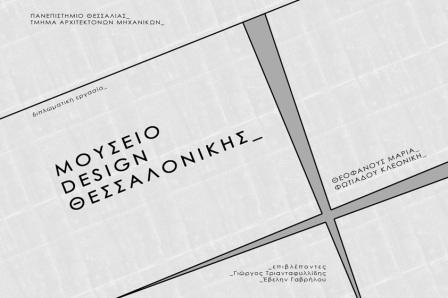

This thesis project deals with the planning of a “design museum” at Nea Paralia, in Thessaloniki. It is a result of a suggestion for housing a collection that was created by Mr. Stergios Delialis twelve years ago, but it is still remains private. This stunning collection currently comprises of more than 3.500 design items and 6000 books that refer to the industrial design of the 20th century.
The chosen building plot belongs to the municipality. It has a triangle shape and it is a green area at the end of Nea Paralia. It is surrounded by important cultural buildings and it is right next to the “Macedonia Palace” hotel. The main consideration for the planning of the plot was the maintenance of the majority of the green area. The main effort was to combine the natural with the structural environment. The architecture composition of the building was based on the topography characteristics and the study of the surrounding plots. The design of the building was carried out by two basic axes: the flow of movements for the museum was executed based on the sense of draught and the gradual development about a big, central atrium, while the main concept of the enlargement of the museum was based on the sense of “exhibit on a pedestal”.
As far as the structure is concerned, the first two floors, which are the base of the building, constitute a heavy structure made of concrete and the third overhead floor is a steel construction that forms a lighter structure than the base. The main facilities of the museum are: permanent and temporary exhibitions, foyer amphitheater, digital screens, library, café – restaurant and workshop room with space for an outdoor exhibition. The purpose of including a workshop is to give an interactive character to the museum and yet to ignite the interest of young people for the concept of “design”. Thus, a place of studying and regular approach of new designing products will be created in Thessaloniki.
Supervisors: Gavrilou Evelyn, Triantafillidis Giorgos
Reference Number: 261


The project is placed on the two axis. The axis of hearing sense and sight. Both of them are intersected in the experience of movement in the space. It is stage on which will take part a audiovisual performance-action. The design has as central axis the attribute of human brain to conceives the point that is found a sound source in the space, from three parameters: pan, delay and pitch. The performance will be given from three members. Each one will take his place on the scene, depending on the instrument that will play. More analytically will take his place according his instrument’s timbre, that it is depend on the three above parameters. The movements will be also in connection with the sound as it changes place the sound source. The music will be in the bigger part improvisational, which means that will be composed instantly in front of the audience. Also what will play the musician, will determine also his movement on the stage. Stage it was drawn as n object in the space, on which will take part the whole action. Aim and bet of planning is the object not only to fulfills the above condition but also to be drawn in such a way that the intervention in the space is in the limit of intervention that would not become end in itself and would not compete what would be supposed it supports, the representation itself.
Supervisor: Kotionis Zissis
Reference Number: 258
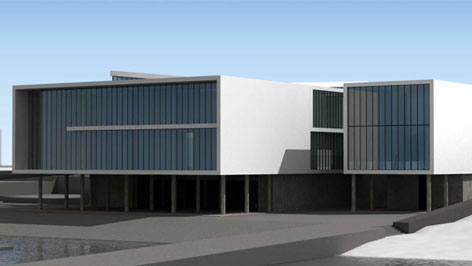

The Nautical Club of Thessaloniki was founded in 1931 and is the oldest sea-sports clubs of the country .It is placed on the waterfront of the city on the boundary of Kalamaria and Thessaloniki municipality.The position of the club refers to an area designated for urban land north of a damaged coastline, then the eastern waterfront of the city known as a new beach, south of the camp Kodra and east of a sufficient driving the increased needs of the region road.
The aims of the redesign and redevelopment of the Nautical Club of Thessaloniki are:
• To redefine the public character of the area
• To promote the specificity character of the region
• to improve and redefine its relationship with the sea area and the liquid component
• To highlight the richness and variety of contact
• To promote the naval group in the 24-hour operation intended to use sport, recreation, culture and working
Space requirements
After the expropriation of the Nautical Club of Thessaloniki for the re-design of space. In this part of the new facilities will include:
• Store boats 900t.m.gia type cruiser, yawi, open catamaran, korsar, pirate, vaurien, boat rowing solo classical, boat, boat racing, Chris Kraft, and warehouses for fitting sails and other regional items Sailing and rowing as ropes, rowing machines, etc.
• Classrooms and seminars for sailors to be able to serve as classrooms modeling of hours training athletes. The rooms are 36 sq.m and they have a capacity of 18 persons each, have room projectors and storage cupboards.
• Clinic for providing first aid to athletes
• Room Teacher
• gymnasium area 110sq.m to prepare the athletes before training
• eightfold to the simulator rowing double height space and area 250 sq.m.
• Locker rooms for men and women with the necessary accommodations (showers, locker) 25 people each, and space wc
. • Area host of athletes, with six bedrooms, two to four persons each
• Exhibition space craft 900t.m.
• lobby to stand and information book
• Area café-restaurant with a capacity of 160 persons will serve both the club and the public of Thessaloniki as well as athletes and members' bar on the second floor
• kitchen, utility rooms and refrigerated rooms for storing food.
• Office administration total 200sq.m to accommodate the accounting and record the group's space and an office manager for information
• Underground parking 50 seats and 20 seats outside
• Space heating systems
• Three staircases for the transportation and service users, goods and exhibits
• Marina area of 2000 sq.m.. can accommodate vessels 50-120 (depending on the size of vessels)
The proposed redesign focuses on the creation of more adequate buildings and outdoor facilities. The storage vessels, coastal and marine configurations sheds (as places of transition) from sea plants were focal points especially as they are called to serve the needs of 800 members of Friends of the Sea and the citizens of Thessaloniki as a whole.
Supervisor: Triantafillidis Giorgos
Reference Number: 306
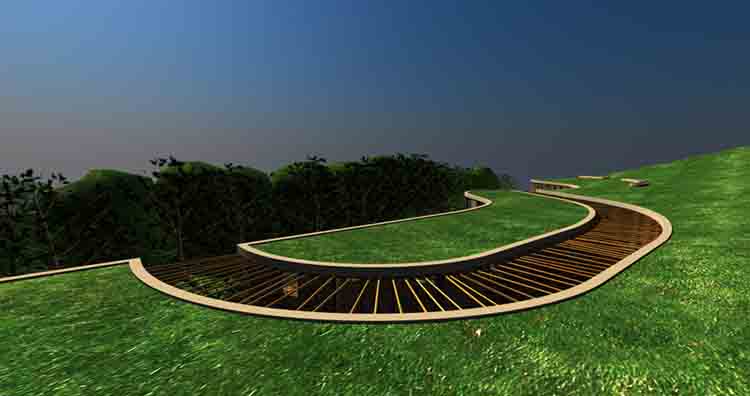

With the traditional meaning of the word, workshop is a covered space, where artistic and/or labor action takes place. This place holds all the tools and materials that the participants will use, to create and learn.
The last years, we have witnessed a change in the meaning of the word “workshop”. With the recent boom of technology, concerning communication (cell phones, internet) and transportation (internal combustion), the word now starts to disconnect from space and focuses more to the human, the participants of the workshop, their interaction, and the way they learn from each other.
Also. we witness workshops that are being performed in unusual places, such as monasteries, old warehouses, in remote villages or even in the countryside. This kind of workshops, take their participants out of their everyday life, and mixes them with people that have a very different social or academic status.
If we tried to give a contemporary meaning to the word “workshop”, we could say that is the creation of a community that uses the subject of the workshop as a central axis for everyday living.
The benefits of such a practice, can be found not only in the lessons themselves, but also and perhaps more importantly, in social interactions between the participants.
In such a context, this thesis, attempts the design of a hostel, a welcoming place, which not only offers the facilities for the host of workshops, but also, through its own planning, offers a ground for the creation and evolution of social relations.
Supervisors: Philippitzis Dimitris, Tsangrassoulis Aris
Reference Number: 303


In the setting of beach the swimmers play the roles of a theatrical. Here the body stars and directs himself. settle, dress, undress, relax, sunbathe, play, exercise. And further: sit, lie down, rise to my feet, enter- come out, set up, fold - unfold, open - close. The swimmer uses his equipment in order to play his role.
A system of outdoor and internal stay for the beach that was designed and manufactured is based on four points:
1. gathering of the basic equipment
2. elongate growth
3. folding/unfolding of equipment
4. standing/seated/lying attitude
The basic household staff is constituted by a bag - a storage and transport space - from which a seat for the outdoor stay and a lodging for internal stay can be unfolded. Into the space that is created in between them, the clothing change cabin is placed. The cabin comes up from a sequence of simple movements of a hat’s transformation into a space intended for the naked body. An additional shade for the seated swimmer may arise from the same hat.
The storyboard that was written and from witch began the design is only the direction of the actions and stool during the use in a day-long stay in the beach.
Supervisor: Kotionis Zissis
Reference Number: 299
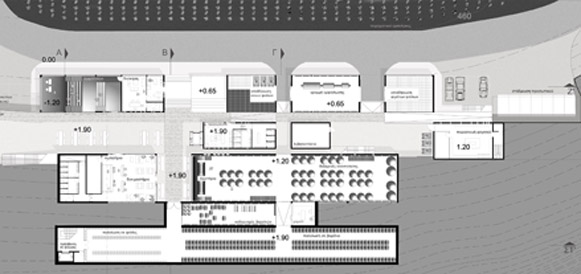

Possessing the largest vineyard of southeastern Europe, Nemea presents itself as an ideal site for designing a winery. Besides the vines, twenty-five centuries of history have left us a significant archaeological site, elements of which influence the creative process, connecting the ancient side of the area, that is the games with the modern which is the wine.
A winery is being suggested on the southwestern end of the valley. Placing it above the vineyard, the winery can supervise both theoretically and practically the crops. What define the design are the horizontal lines, which act as a border between the cropped acres of the valley and the wild nature of the mountain. The linearity of the building is a reference to the roads that connect the wineries of the network “wine roads”.
The winery uses 3 levels, taking advantage of the pitch. The entrance of the grapes is on one level, the exit of the finished wine on another and a third level in between is for the visitors. The visitor follows the path of the wine walking on a parallel corridor, separated from the production rooms by a transparent glass surface, that lets them watch but not interfere, protecting the quality of the final product. The wine-cellar is the only part of the winery, where the path of the visitor coincides with the production process.
The secret pathway in the archaeological area of Nemea that connected the stadium with the vestry triggered this study. Sheltered corridors to both directions are integrated into the design, connecting several spaces of the building. Two pathways intersect the building vertically, ending at the underground oblong wine-cellar and two horizontal pass through it as movement pathways.
The winery is a short stop in the grape’s route from the vine to the table.
Supervisor: Papadopoulos Lois
Reference Number: 315
.jpg)
.jpg)
The site is located in the entrance of the city of Volos next to the Pedion Areos house to the Departments of the School of Technological Sciences, the proposal is suggesting a full design of the area that includes a student house of 130 apartments, a restaurant of 335 seats, a student union, a building with a lecture theatre of 360 seats and a shop. The landscape design is connecting these building and at the same time is turning into a meeting point for all the student of the university. The site is divided into 2 areas, the one is facing east with the student House (private use) and the other faces north, to the Athens Avenue where we find the building of public use, restaurant, lecture theatre and the shop. The landscape and the planting is reinforcing the circulation, giving you a strong feeling of movement and orientation. The Krausidonas river a nature border of the city of Volos is having an important meaning to the design of the masterplan of this proposal.
Supervisor: Kanarelis Theoklis
Reference Number: 272
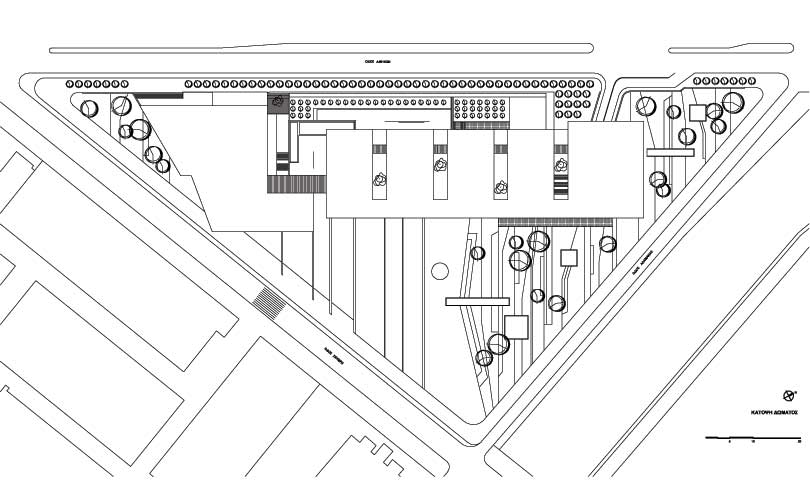

This work is a proposal for the academic installations of Computer Engineers Telecommunications and Networks department in Volos.
The study concerns the triangular site that is set by the roads Alamanas, Sekeri and Athens Avenue, space in which is planned, with the Regulating plan, the expansion of University of Thessaly.
The site is found in the limits of urban complex of Volos and today, in a part of it, stands the nursery of Volos municipality and the remaining space is occupied by abandoned industry buildings.
The department of Computer Engineers Telecommunications and Networks is a five-year study and it is separated in two circles, for which is required specific number of classrooms (about 30).
The proposal includes still: Auditorium, amphitheatric teaching classrooms, offices and auxiliary spaces for 40 teachers, a small library, secretariat, a tuck-shop, underground parking and hygiene areas.
Supervisor: Triantafillidis Giorgos
Reference Number: 304

